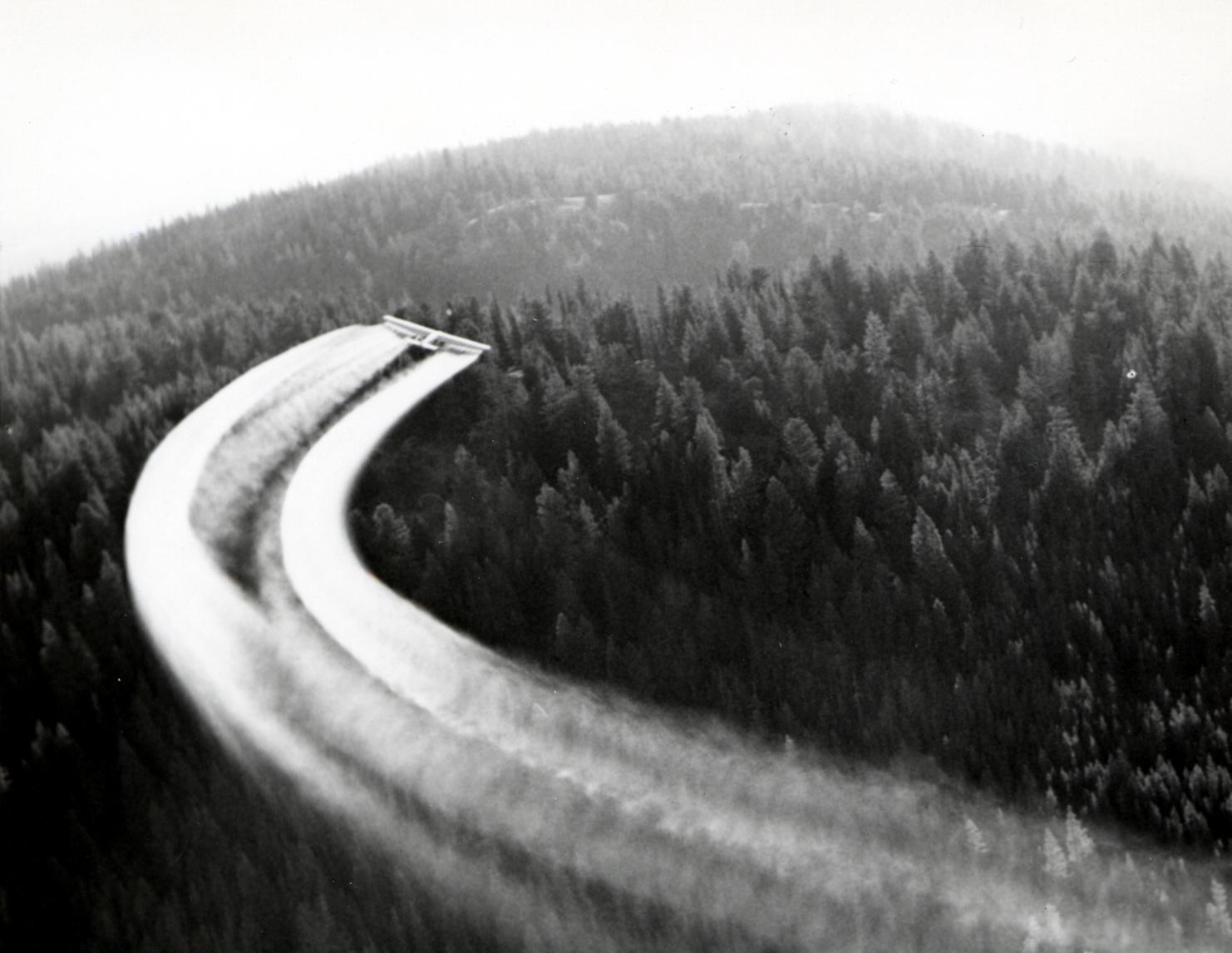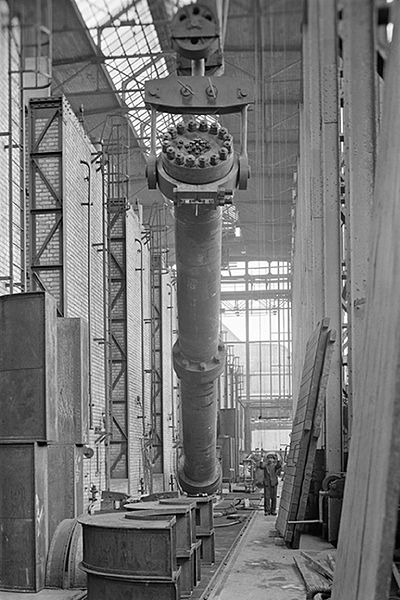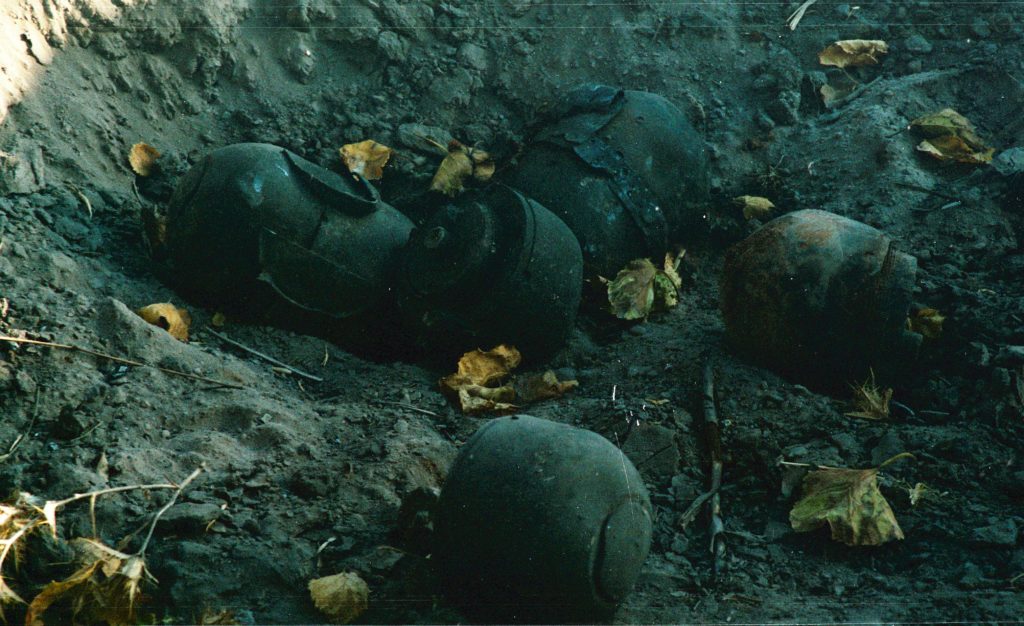
by Tina Beigi and Michael Picard
World War II ended more than half a century ago. Yet stumbling upon unexploded bombs in Germany is still a frequent occurrence. Of the roughly quarter million bombs that did not explode during the war, thousands are still buried underground all over Germany. One of these left-over bombs self-ignited recently in Limburg’s countryside. The blast of the 250kg explosive occurred in a field of barley in the middle of the night and was large enough to dig a crater 10 metres wide and 4 metres deep.
This accident is a welcome occasion to revisit the concept of slow violence coined by Rob Nixon. He describes this phenomenon as ‘a violence that occurs gradually and out of sight, a violence of delayed destruction that is dispersed across time and space, an attritional violence that is typically not viewed as violence at all.’ This concept reminds us that violence is not always what we expect it to be, explosive and sensationally visible but can be incremental and generate unpredictable outcomes across spatial and temporal scales.
The buried past exploding in the present is a haunting metaphor for the bombing of the future through endless environmental exploitation.
One may ponder whether the detonation of a decade-long silent bomb is a powerful metaphor for the slow violence of time compression and space destruction. Whereas past bombs remain deadly decades after they were dropped, current techniques of industrial agriculture function like a buried bomb, threatening a sustainable future. When these ‘climate bombs’ explode, it could mean the annihilation of life itself on the planet. In this way we can see the past, present, and future colliding in explosive fury. In Germany, just as Allied bombing raids (from above) failed to detonate instantly, industrial agriculture (down below) will continue to distribute persistent pollutants into the future, eventually detonating beyond the spatial and temporal boundaries of the land. The entanglement of weapons of mass destruction and weapons of mass production ultimately compresses time and space into a forever impending catastrophe. In a strange inversion on the horizon of temporality, we could be reaching a point in history when the buried past exploding in the present serves as a haunting metaphor for the bombing of the future through endless environmental exploitation.
Historical entanglements of war, agriculture and climate change

When contemplating the detonation of a WW2 bomb in a German field, one is struck by the disorienting compression of history, in which war pollution caused by a 20th Century conflict returns to haunt the peaceful lives of 21st Century farmers. From a temporal perspective one generation of pilots’ aerial bombing time travels to reach another generation of peacetime farmers, blurring the temporal lines between war and peace. The legacy of warfare in peacetime extends far beyond the traumatic legacy imprinted on the social fabric and reaches the material foundations of welfare itself. From a spatial perspective, the explosive legacy of Allied strategic bombing over Germany parallels another type of aerial campaign, involving the heavy spraying of chemical fertilizers to improve agricultural yields. Just as war remnants explode upon industrial agricultural production today, fumigating raids have been systematically bombing crops since the inter-war years with pesticides and nitrogen-enriched fertilizers. One such toxic legacy that radically transformed the industry was developed by German scientist Haber-Bosch, whose process to produce ammonia was as critical in the manufacturing of plant fertilizers as it was in developing the Zyklon B poison gas used during the Holocaust. In a parallel twist, the development of chemical insecticide presently used for industrial-scale agricultural production is thus intimately related to transformations in chemical warfare designed for genocide.
Transfers between war and agriculture operated at both the technological and the ideological level. The co-production of techniques of agricultural and military control blurred the boundaries between insects and humans, friend and foe, domestic pest control in peacetime, and enemy annihilation in wartime. For instance, the development of chlorinated gases during WW1 demonstrated the insecticidal properties of certain organochloride compounds. After the conflict, the chemical industry, profiting greatly from war, promoted the conversion of its offensive poison gas arsenal to pesticide application. The same planes, which had spread poison gas over enemy lines, were used to spread herbicides, strengthening the alliance between the military and the budding post-war mechanization of agri-business. After WW2, Dichlorodiphenyltrichloroethane, commonly known as the chlorinated aromatic hydrocarbon DDT, emerged from the technical imaginary of modern warfare, while warfare legacies like nerve gases emerged from agricultural processes to protect crops from pests. Paralyzing gases, such as Sarin, demonstrated a similar effect on humans as on insects. After WW2, retired bomber pilots would indiscriminately shower the countryside with millions of tons of poisonous pesticides. Chemical warfare was successively waged as much on the battleground as on food crops, fuelling a reciprocated sociotechnical imaginary involving both the sanitization of food and the synthetization of war. The blurring of boundaries between war and peace was most apparent during the Cold War, when defoliants like Agent Orange, developed from agricultural herbicides, were sprayed on Communist enemies in South East Asia. In this case, the mutagenic effects on human populations persisted for decades later.
The co-production of techniques of agricultural and military control blurred the boundaries between insects and humans, friend and foe, domestic pest control in peacetime, and enemy annihilation in wartime.
A remnant WW2 bomb, which randomly exploded in Germany’s countryside in 2019, symbolizes the indistinction between techniques of military destruction and techniques of industrial agricultural production, both predicated on eradication campaigns. Just as mass warfare indiscriminately kills soldiers and civilians alike, modern farming methods contribute to indiscriminate bombing of not only pests, but fragile and diverse ecosystems. Nitrogen fertilizers increase agricultural yields, yet accentuate global warming and pollute water-tables, rivers and estuaries with excessive nitrates. Whereas 3% of the human population perished in WW2, a recent study shows that over 40% of insect population have gone extinct through the intensive use of pesticides developed by the same war machines. Here, the warplane and aerial pesticide-spraying aircraft emblematically collide and violently explode in a dustbowl of ecological disaster.
At the risk of taking a shortcut, could military explosives have been detonated by the long-term effects of industrial chemicals? While the explosive devices used in war have an almost-guaranteed immediate effect upon impact, fertilizers and pesticides have gradually contaminated and decimated the biological diversity of landscapes over the span of a century. What is truly remarkable is that the incessant application of chemical fertilizers may well have been the powder keg responsible for the recent ignition of the rusty WW2 bomb in the German countryside. Recent reports suggest, idle undetonated bombs are triggered by heatwaves, which are in turn exacerbated by climate change, in large part due to industrial agriculture. Climate disruption and the recurrence of seasonal heatwaves have been amplified as a result of the compound effect of methane emissions from agriculture and of the heavy use of nitrogen-based fertilizers releasing nitrous oxide emissions. In turn, climate shocks like drought and heat waves exert enormous pressure on surface and ground-water levels. The entanglement of buried bombs and climate change intersects across the European countryside, illustrating feedback loops between war, industrial agriculture, climate change, and food insecurity.
Military and climate disruptions mirror each other in what seems to be an endless feedback loop of fire and fury.
When buried bombs of the past detonate inside the boundaries of our present era, they parallel public concerns with the current ecological crisis. Increasingly frequent heatwaves and changing weather patterns are harming crop yields and raising concerns around animal welfare, indicating that climate shocks, such as drought threaten food production. European firefighters are now fighting a strange war on two fronts: a climate war with a firehose against wildfires and a war against explosive remnants of WW2, using battle tanks to shield themselves from the blaze.
Analysts have recently drawn comparisons between WW2 and the climate crisis, claiming ‘global warming has heated the oceans by the equivalent of one atomic bomb explosion per second for the past 150 years.’ Further analogies between modern warfare and the climate crisis can be drawn from the emergency drop by a Swedish Air Force fighter jet of a 500-pound precision laser-guided bomb near a fire approaching a military firing range. Donald Trump made the uncanny quip recently of dropping nukes to stop increasingly killer hurricanes. Such extreme examples show how the perpetuation of war and climate change are undeniably linked. Since its carbon bootprint contributes to the greenhouse effect, the military fuels the very fire it attempts to extinguish, one bomb at a time. What the news headlines from Europe confirm is that military and climate disruptions mirror each other in what seems to be an endless feedback loop of fire and fury.
Fumigating the future

On the other side of Germany, in a strange coincidence, another event was taking place around the time of the WW2 bomb detonation in relating the past and future to the present state of environmental degradation. A surprise attack and partial occupation of a coal mine was organized by the environmentalist group End of the line in the Rhineland region. The occupation of the mine was motivated by its disapproval with the utility company RWE and their plan to cut down an old growth forest to make way for the enlargement of the mine. Such plans for expansion, protestors claim, would turn the Rhine district into one of the largest CO2 emitters in Europe.
This time, the strategic site was not occupied by the Allied armies against the abrupt violence unleashed by a world conflict, but by peaceful climate activists protesting against the slow violence of mining expansions. By sundown, the police launched teargas to dislodge the activists out of the coal mine. Police literally fumigated the climate protesters in the same way farmers fumigate insects.
The strange, or maybe timely coincidence, of both events on German soil: the detonation of a WW2 bomb, and the surprise occupation of a coal mining crater by an army of green activists, highlights the overlapping toxic legacies of successive historical periods. While the first reveals how old war contamination may unpredictably creep out of the past, the second anticipates a massive climate shock looming in the future.
In the same way that the legacy of WW2 bombing occasionally haunts the present, we are still haunted by one of the oldest and dirtiest resources of capitalism’s historical trajectory: coal. Why is that so? The history of energy usage is not one of transitions, but rather of successive additions of new sources of primary energy. Indeed, world energy markets never fully transitioned from coal to petroleum; similarly, it is highly improbable that a transition will entirely take place from petroleum to renewable energy.
Police literally fumigated the climate protesters in the same way farmers fumigate insects.
Fossil fuel extraction and pollution is the legacy of the past taking effect in the present and locking-in possibilities for future decades to come. The Earth’s atmosphere is already damaged by the 1,500 billion tons of carbon dioxide emitted by the coal economy. In a similar way in which war remnants caused by a 20th Century conflict impacts the lives of 21st Century farmers, 18th Century models of energy production are still operational in the 21st Century, with all their damaging effects across time and space. The hard divisions in the destruction of life between past and present and an always improving future is merely an illusion from this view.
Tragedy or farce?

To summarize, the ignition of bombs and the expansion of mines suddenly converged in the past months to illustrate a legacy of slow accumulative violence, transcending space and time in the German countryside. What does such an entanglement reveal about our era? The contemporary moment of social and environmental emergency synchronizes weapons of mass destruction with weapons of mass production. The synchronization of warfare and welfare has provoked, on the one hand, the destruction of geographic space, resulting in the displacement and contamination of human communities and natural habitat. On the other hand, their synchronization has meant the compression of time available for the Earth to regenerate from exploitation.
Bombs of the past haunt our present, while bombs of the present inevitably preordain our future. The real catastrophe, as German philosopher Walter Benjamin claimed, is not some isolated apocalyptic event but rather the perpetuation of the continuous flow of the logic of capital and its wake of destruction across time and space. The accidental detonation of a WW2 bomb interrupted only the routine of a farmer, whereas a perpetual fossil-fueled war predicated on capital accumulation is waged daily against the regenerative capacities of the Earth, threatening a sixth mass extinction.
The contemporary moment of social and environmental emergency synchronizes weapons of mass destruction with weapons of mass production.
Hegel claimed that history is cyclical and repeats itself. Marx added that history repeats itself, first as tragedy and then as farce. As reflected in this piece we may add, in a strange succession of events, history is compressing time and eroding space, by accelerating the rate at which farce and tragedy repeat themselves simultaneously. The tragedy lies in the annulment of future life potentials by military planes and mining cranes; the farce is the destruction by the military and industry of the material conditions of their own reproduction. The tragedy is also in the fumigation of farms by industrial agriculture, while the farce is a regressive state-sanctioned police force fumigating activists who attempt to protect the very conditions for the maintenance of life on Earth.
Tina Beigi is an environmental engineer who is currently pursuing a PhD in Ecological Economics at McGill university.
Michael Picard is a research fellow at the Institute for Global Law & Policy of the Harvard Law School and teaches International Law at Sherbrooke University.
The authors would like to thank Vijay Kolinjivadi and Elliot Blomqvist for their precious editorial feedback on preliminary drafts. The usual caveat applies.